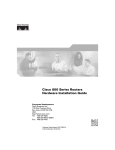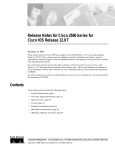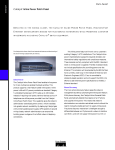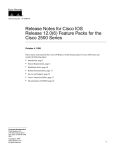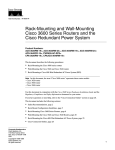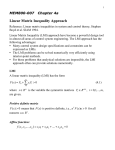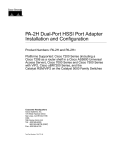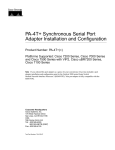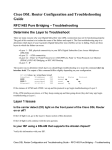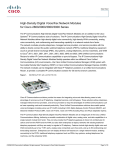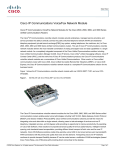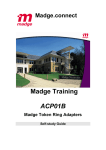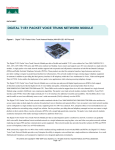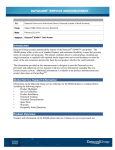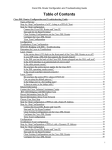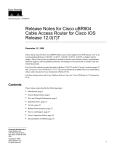Download Cisco FactoryUpgrade 8MB DRAM to 12MB 800Series (B)
Transcript
Release Notes for Cisco IOS Release 12.0(7)XV Feature Packs for the Cisco 800 Series Routers January 24, 2000 These release notes describe the Cisco IOS Release 12.0(7)XV feature packs for Cisco 800 series routers and contain the following topics: • Introduction, page 1 • System Requirements, page 3 • Installation Notes, page 11 • Related Documentation, page 24 • Service and Support, page 29 • Cisco Connection Online, page 30 • Documentation CD-ROM, page 31 Introduction List of Terms The following terms are used throughout this document: • Feature—Networking functionality command(s) that support networking technology and hardware. For example: Double Authentication, IP Multicast over Token Ring, Voice Over IP, and PPP over ATM. • Feature pack—A small box containing software images, applications and documentation on CD-ROMs, and hardcopy documentation. Feature packs provide software upgrades for many of the Cisco hardware platforms. Corporate Headquarters: Cisco Systems, Inc., 170 West Tasman Drive, San Jose, CA 95134-1706 USA Copyright © 2000. Cisco Systems, Inc. All rights reserved. Introduction • Feature set—A group of features. For example: IP, IP Plus, Enterprise Plus, and IP Sec 56 • Image—Software code containing a Cisco IOS feature set. The image file naming nomenclature, such as c800-y6-mw, c1000-bnsy40-mz, and c2500-g-l, specifies a platform, feature set, and file compression method. For example, c4500-is56i-mz indicates: – Platform: (c4500) 4500 platform. – Feature set: (is56i) IP Plus IP Sec 56. – Compression method: (mz) RAM, zip compressed. How to Use These Release Notes The tables in these release notes contain details about the Cisco feature packs. Use these tables to perform the following tasks before loading a software image onto a router: 1. Use Table 1, “Cisco 800 Series Default Memory and Upgrade Options,” for the feature set memory requirements, factory-default memory, and available memory upgrades for your Cisco 800 router. 2. Use Table 3, “Feature Pack Product Numbers Quick-Reference List,” to identify the software image you want to load. 3. Use Table 4, “Cisco 800 Series Routers Feature Packs,” to identify your feature pack and the memory required for your feature set, based on the image you load. 4. Use the tables in the “Feature Set Tables” section on page 6 to identify which features are supported in a feature set image. Feature Pack Components The feature pack box typically contains the following items: • A CD-ROM with the following software: – Cisco IOS feature set software images that can include bundled modem firmware. – The Router Software Loader (RSL) program (a Windows 95 application) that loads images onto your Cisco 800 series router. – Trivial File Transfer Protocol (TFTP) server application (for Windows 95 only). • Getting Started with the Router Software Loader. Note If you cannot use the RSL to load images, you can follow the instructions in the “Alternatives to the RSL” section on page 12. • Release notes (this document). • Other configuration or command references, if available. • Software license for using Cisco software in object code form on a single access server or router. • Documentation CD-ROM that contains all Cisco documentation. Release Notes for Cisco IOS Release 12.0(7)XV Feature Packs for the Cisco 800 Series 2 78-10446-01 System Requirements System Requirements This section describes the following topics: • Memory Defaults and Upgrade Options, page 3 • Hardware Supported, page 3 • Software Compatibility, page 4 • Determining Your Software Release, page 4 • Updating Your Software Release, page 4 • Product Numbers Quick-Reference List, page 5 • Feature Pack Overview Table, page 5 • Feature Set Tables, page 6 Memory Defaults and Upgrade Options Table 1 Cisco 800 Series Default Memory and Upgrade Options Memory Type Cisco 801-804 Defaults Flash memory card 8 MB 4-MB to 8-MB upgrade: MEM800-4U8F 8-MB to 12-MB upgrade: MEM800-8U12F DRAM 4 MB 4-MB to 8-MB upgrade: MEM800-4U8D 4-MB to 12-MB upgrade: MEM800-4U12D Upgrade Options Hardware Supported Cisco IOS Release 12.0(7)XV supports the following Cisco 800 series routers: Caution • Cisco 801 • Cisco 802 • Cisco 803 • Cisco 804 Cisco IOS Release 12.0(7)XV supports the Cisco 801–804 series routers only. Table 2 Supported Interfaces for the Cisco 801–804 Series Routers Router Ethernet Ports ISDN Ports Telephone Ports Cisco 801 One 10BaseT (RJ-45) ISDN BRI S/T (RJ-45) – RJ-45 Cisco 802 One 10BaseT (RJ-45) ISDN BRI U, integrated Network Termination 1 (NT-1) (RJ-45) RJ-45 – Console Ports Release Notes for Cisco IOS Release 12.0(7)XV Feature Packs for the Cisco 800 Series 78-10446-01 3 System Requirements Table 2 Supported Interfaces for the Cisco 801–804 Series Routers (continued) Router Ethernet Ports ISDN Ports Telephone Ports Cisco 803 Four-port 10BaseT (RJ-45) hub ISDN BRI S/T (RJ-45) Two (RJ-11) RJ-45 Cisco 804 Four-port 10BaseT (RJ-45) hub ISDN BRI U, integrated NT-1 (RJ-45) RJ-45 Two (RJ-11) Console Ports The Cisco 800 series routers provide the following key hardware features: • Cisco 802 and Cisco 804 routers have an integrated NT-1, which eliminates the need for an external NT-1 in North America. • Cisco 803 and Cisco 804 routers provide connection to analog telephones, fax machines, or modems, which are connected to telephone services through an Integrated Services Digital Network (ISDN) line. • Flash memory: Default is 8 MB, expandable to 12 MB. • Dynamic RAM: Default is 4 MB, expandable to 12 MB. • ISDN B-channel LEDs are a different color from the other LEDs, which make them easy to distinguish. • Color-coded ports and cable reduce the chance of cabling errors. • Routers can be stacked or mounted on a wall. Software Compatibility The feature packs described in these release notes contain Cisco IOS Release 12.0(7)XV software images, some images from previous software releases, and the RSL Version 7.3. Determining Your Software Release To determine the version of Cisco IOS software running on your Cisco 800 series, log in to the router and enter the show version EXEC command: router> show version Cisco Internetwork Operating System Software IOS (tm) 800 Software (C800-NSY6-MW), Version 12.0(7)XV, RELEASE SOFTWARE Updating Your Software Release For information on upgrading to a Cisco IOS Release 12.0 T software release, see the product bulletin Cisco IOS Software Release 12.0 T Upgrade Paths and Packaging Simplification (#819: 1/99) on CCO at: Service and Support: Product Bulletins: Software Under Cisco IOS 12.0, click Cisco IOS Software Release 12.0 T Upgrade (#819: 1/99). Release Notes for Cisco IOS Release 12.0(7)XV Feature Packs for the Cisco 800 Series 4 78-10446-01 System Requirements Product Numbers Quick-Reference List Table 3 Feature Pack Product Numbers Quick-Reference List Product Number Feature Pack Description CD08-BP-12.0.7.XV= Cisco 800 Series IP IPX Plus Feature Pack 12.0(7)XV CD08-BHL-12.0.7XV= Cisco 800 Series IP IPX, FW, Plus IPSec Feature Pack 12.0(7)XV CD800-1CAPI= Cisco 800 Series IP Upgrade Feature Pack Release 12.0(7)XV RSL Version 7.3 (CAPI Software one-user license) CD800-5CAPI= Cisco 800 Series IP Plus Upgrade Feature Pack Release 12.0(7)X RSL Version 7.3 (CAPI Software five-user license) Feature Pack Overview Table Table 4 Cisco 800 Series Routers Feature Packs Image Name (UNIX) Image Name (DOS) Flash Memory Required Main Memory Required RSL Installer Description Product Number CD-ROM Title CD08-BP-12.0.7.XV= Cisco 800 Series c800-nsy6-mw IP/IPX Plus Feature Pack Release 12.0(7)XV RSL Version 7.3 aaa1167 8 MB 4 MB Cisco 800 Series IP IPX Plus Feature Pack 12.0(7)XV CD08-BHL-12.0.7XV= Cisco 800 Series c800-nosy656i-mw IP/IPX/FW/Plus/ IPSec Feature Pack Release 12.0(7)XV RSL Version 7.3 aaa1168 8 MB 8 MB Cisco 800 Series IP IPX, FW, Plus IPSec Feature Pack 12.0(7)XV CD800-1CAPI= Cisco 800 Series c800-y6-mw IP Feature Pack Release 12.0(7)XV RSL Version 7.3 (CAPI Software one-user license) aaa1169 8 MB 4 MB Cisco 800 Series IP Feature Pack 12.0(7)XV(CAPI Software one-user license) CD800-5CAPI= Cisco 800 Series c800-y6-mw IP Plus Feature Pack Release 12.0(7)XV RSL Version 7.3 (CAPI Software five-user license) aaa1170 8 MB 4 MB Cisco 800 Series IP Plus Feature Pack 12.0(7)XV(CAPI Software five-user license) Release Notes for Cisco IOS Release 12.0(7)XV Feature Packs for the Cisco 800 Series 78-10446-01 5 System Requirements Feature Set Tables The Cisco IOS software is packaged in feature sets consisting of software images—depending on the platform. Each feature set contains a specific set of Cisco IOS features. Release 12.0(7)XV supports the same feature sets as Release 12.0 T, but Release 12.0(7)XV can include new features supported by the Cisco 800 series. Table 5 Feature Sets Supported by the Cisco 800 Series Image Names Feature Set Matrix Term Software Image Platforms IP Basic2 c800-y6-mw Cisco 801–804 c800-sy6-mw Cisco 801–804 3 In1 IP Plus Plus IP/IPX Plus Plus c800-nsy6-mw Cisco 801–804 IP/Firewall Basic c800-oy6-mw Cisco 801–804 IP/Firewall Plus Plus c800-osy6-mz Cisco 801–804 (5)T c800-osy656i-mw Cisco 801–804 (5)T c800-nosy656i-mw Cisco 801–804 (5)T IP/FW/Plus/IPSec 56 Plus, IPSec 56 IP/IPX/FW/IPSec 56/Plus Plus, IPSec 56 4 1. The number in the “In” column indicates the Cisco IOS release when the image was first introduced. For example, (5)T means an image was introduced in Release 12.0(5)T. If a cell in this column is empty, the interface was included in the initial base release. 2. This feature set is offered in the basic feature set. 3. This feature set is offered in the Plus feature set. 4. This feature set is offered in the encryption feature sets, which consist of IPSec 56-bit (Plus IPSec 56) data encryption feature sets. Caution Cisco IOS images with strong encryption (including, but not limited to 168-bit (3DES) data encryption feature sets) are subject to United States government export controls and have limited distribution. Strong encryption images to be installed outside the United States may require an export license. Customer orders may be denied or subject to delay due to United States government regulations. When applicable, the purchaser or the user must obtain local import and use authorizations for all encryption strengths. Contact your sales representative or distributor for more information, or send an e-mail to [email protected]. Table 6 and Table 7 list the features and feature sets supported by the Cisco 801–804 routers in Cisco IOS Release 12.0(7)XV. Both tables use the following conventions: Note • Yes—The feature is supported in the software image. • No—The feature is not supported in the software image. • In (column)—indicates the Cisco IOS release when the image was first introduced. For example, (5)T means an image was introduced in Release 12.0(5)T. If a cell in this column is empty, the interface was included in the initial base release. This feature set table only contains a selected list of features. This table is not cumulative—nor does it list all the features in each image. Release Notes for Cisco IOS Release 12.0(7)XV Feature Packs for the Cisco 800 Series 6 78-10446-01 System Requirements Table 6 Feature List by Feature Set for the Cisco 801–804 Routers Feature Set IP/FW Plus IP/FW/Plus/ IPSEC56 (VPN) IP/IPX/FW/ IPSEC56/ Plus IP IP Plus IP/IPX Plus IP/FW PAT (NAT Overload) Yes Yes Yes Yes Yes Yes Yes NAT Yes Yes Yes Yes Yes Yes Yes No No No No No No No Call Forward (Sweden and Finland only) Yes Yes Yes Yes Yes Yes Yes Call Forward Variable (North America only) Yes Yes Yes Yes Yes Yes Yes Call Hold Retrieve (North America only) Yes Yes Yes Yes Yes Yes Yes Call Transfer (North America only) Yes Yes Yes Yes Yes Yes Yes Call Waiting Yes Yes Yes Yes Yes Yes Yes Caller ID (North America only) Yes Yes Yes Yes Yes Yes Yes Data-Over-Voice Bearer (North America only) Yes Yes Yes Yes Yes Yes Yes Distinctive Ringing Yes Yes Yes Yes Yes Yes Yes ISDN-Voice Priority Yes Yes Yes Yes Yes Yes Yes GRE Tunneling No Yes Yes No Yes Yes Yes NAT Yes Yes Yes Yes Yes Yes Yes PAP, CHAP, MSCHAP, Local Password Yes Yes Yes Yes Yes Yes Yes Yes Yes Yes Yes Yes Yes Yes Yes Yes Yes2. Yes Yes Yes Yes Yes Yes Yes Yes Features In Address Conservation NAT with H.323 Advanced Telephone Features 1 Basic Services Ease of Use and Deployment Auto SPID / Switch Detection (3)T Cisco ConfigMaker 2 Cisco FastStep Yes Yes Yes Configuration Express Yes Yes Yes Yes Yes Yes Yes Easy IP Phase I and II (IPCP Address (3)T Negotiation and DHCP Server) Yes Yes Yes Yes Yes Yes Yes TFTP Client and Server Yes Yes Yes Yes Yes Yes Yes AppleTalk No No No No No No No IP Yes Yes Yes Yes Yes Yes Yes IPX No No Yes No No No Yes LAN Release Notes for Cisco IOS Release 12.0(7)XV Feature Packs for the Cisco 800 Series 78-10446-01 7 System Requirements Table 6 Feature List by Feature Set for the Cisco 801–804 Routers (continued) Feature Set IP/FW Plus IP/FW/Plus/ IPSEC56 (VPN) IP/IPX/FW/ IPSEC56/ Plus IP IP Plus IP/IPX Plus IP/FW NetBIOS Access Lists Yes Yes Yes Yes Yes Yes Yes Transparent Bridging Yes Yes Yes Yes Yes Yes Yes Cisco View Yes Yes Yes Yes Yes Yes Yes SNMP, Telnet, Console Port Yes Yes Yes Yes Yes Yes Yes SNTP Yes Yes Yes Yes Yes Yes Yes Syslog No Yes Yes No Yes Yes Yes BGP No No No No No No No EGP No No No No No No No IGRP No No No No No No No IP Enhanced IGRP No Yes Yes No Yes Yes Yes IP Multicast (relay only) No Yes Yes No Yes Yes Yes IP-Policy Routing No Yes Yes No Yes Yes Yes IPXWAN No No Yes No No No Yes OSPF No No No No No No No RIP, RIPv2, Triggered RIP Yes Yes Yes Yes Yes Yes Yes AAA Radius No No No No No No No AAA TACACS+ No No No No No No No Additional Vendor-Proprietary RADIUS Attributes No No No No No No No Authenticating ACL No No No No No No No Automated Double Authentication (server functionality) No No No No No No No Certificate Authority Interoperability3 No No No No No No No Internet Key Exchange Security Protocol No No No No No No No No No No No No Yes Yes Features In Management Routing Security IPSec Network Security (5)T Release Notes for Cisco IOS Release 12.0(7)XV Feature Packs for the Cisco 800 Series 8 78-10446-01 System Requirements Table 6 Feature List by Feature Set for the Cisco 801–804 Routers (continued) Feature Set IP/FW Plus IP/FW/Plus/ IPSEC56 (VPN) IP/IPX/FW/ IPSEC56/ Plus IP IP Plus IP/IPX Plus IP/FW No No No Yes Yes Yes Yes – Java Blocking No No No Yes Yes Yes Yes – Denial of Service Detection and No No No Yes Yes Yes Yes No No No Yes Yes Yes Yes IPSec Encryption with 56 bit DES No No No No No Yes Yes Lock and Key Yes Yes Yes Yes Yes Yes Yes LT2P No No No No No Yes Yes Named Method Lists for AAA Authentication & Accounting No No No No No No No Route and Router Authentication Yes Yes Yes Yes Yes Yes Yes Token Card - Double Authentication Yes Yes Yes Yes Yes Yes Yes Yes Yes Yes Yes Yes Yes Yes Frame Relay Encapsulation (for ISDN LL) Yes Yes Yes Yes Yes Yes Yes ISDN Digital Subscriber Line (IDSL) Yes Yes Yes Yes Yes Yes Yes Frame Relay Inverse ARP No No No No No No No ISDN Yes Yes Yes Yes Yes Yes Yes ISDN Leased Line (up to 144 kbps) Yes Yes Yes Yes Yes Yes Yes ML-PPP, PPP Compression Yes Yes Yes Yes Yes Yes Yes Mobile IP No No No No No No No PPP over Frame Relay (RFC 1973) No No No No No No No (7)XV Yes Yes Yes Yes Yes Yes Yes Always On/Dynamic ISDN (AO/DI) No Yes Yes No Yes Yes Yes Bandwidth on Demand (BOD) Yes Yes Yes Yes Yes Yes Yes Dial on Demand (DDR) Yes Yes Yes Yes Yes Yes Yes HRSP No No No No No No No Features In IOS Firewall Phase I – Context Based Access Control Lists Prevention – Real-time Alerts and Audit Trails Voice Technologies Called Party Number Port (5)T WAN (Remote) Common Application Programming Interface (CAPI & RCAPI)4 WAN Optimization Release Notes for Cisco IOS Release 12.0(7)XV Feature Packs for the Cisco 800 Series 78-10446-01 9 System Requirements Table 6 Feature List by Feature Set for the Cisco 801–804 Routers (continued) Feature Set IP/FW Plus IP/FW/Plus/ IPSEC56 (VPN) IP/IPX/FW/ IPSEC56/ Plus IP IP Plus IP/IPX Plus IP/FW IPX and SPX Spoofing No No Yes No No No Yes ISDN Caller ID Callback Yes Yes Yes Yes Yes Yes Yes Snapshot Routing Yes Yes Yes Yes Yes Yes Yes Stac Compression Yes Yes Yes Yes Yes Yes Yes Yes Yes Yes Yes Yes Yes Yes No Yes Yes No Yes Yes Yes Features In Time-based Access Lists (3)T X.25 ID 1. Advanced Telephone Features are available on the Cisco 803 and 804 routers only. These features require supplementary services from a telephone company. 2. The X.25 configuration feature requires the use of the Cisco command line interface (CLI). 3. Interoperability with Certification Authority servers from VeriSign is not supported for IPSec in Release 12.0(5)T and earlier releases on Cisco 800 series routers. 4. The CAPI and RCAPI feature is part of the base software image, therefore it is included in all images. The Cisco 800 series routers also support the features listed in Table 7. Table 7 Additional Features supported by Cisco 800 Routers Feature IP IP Plus IP/IPX Plus IP/FW IP/FW Plus IP/FW/Plus/ IPSec IP/FW/Plus/ IPSec Plus Routed Protocol IP IP IP/IPX IP IP IP IP/IPX Routing Protocol RIP RIP/IPEIGRP RIP/IPEIGRP/ IPX WAN RIP/IPEIGRP RIP/IPEIGRP RIP/IPEIGRP Snapshot Snapshot Snapshot RIP/IPEIGRP/ IPX WAN Snapshot Snapshot Snapshot Snapshot Tunneling GRE GRE GRE GRE GRE X.25 X.25 X.25 X.25 X.25 X.25 SNTP SNTP SNTP SNTP SNTP SNTP (Simple Network Time Protocol) SNTP Multicast SNTP IP Multicast IP Multicast Forwarding Forwarding IP Multicast IP Multicast IP Multicast Forwarding Forwarding Forwarding Management SNMP SNMP/ SYSLOG SNMP/ SYSLOG SNMP SNMP/ SYSLOG SNMP/ SYSLOG SNMP/ SYSLOG Manual ISDN Calls (see reference for commands) Yes Yes Yes Yes Yes Yes Yes Release Notes for Cisco IOS Release 12.0(7)XV Feature Packs for the Cisco 800 Series 10 78-10446-01 Installation Notes Installation Notes This section describes the following topics: • Image Installation Tips and Troubleshooting When Using The RSL, page 11 • Alternatives to the RSL, page 12 • Common Application Programming Interface, page 15 Image Installation Tips and Troubleshooting When Using The RSL Image Installation Tips The following information about RSL operations can help you with the installation process: • If you are loading software on a preconfigured Cisco 800 series router, save the router configuration file on your PC before running the RSL. • If you have added any static entries to the PC Address Resolution Protocol (ARP) table, one or more of them may be deleted by the RSL. Manually re-enter any deleted entries in the PC ARP table. • During a connection, if the Cisco 800 series router running configuration is not the same as its startup configuration, the exact configuration is not restored. Any changes that you made since the last time you entered copy running-config startup-config or write memory commands are lost. • The RSL restores the Cisco 800 series router startup configuration, but some running configuration commands are not restored. To restore the exact running configuration, reboot the router. The following interface configuration commands are not restored to the running configuration: – no shutdown – no ringspeed – media-type aui Recovering from a Connection Error If any of the following elements apply to your installation, modify the Short Timeout value from the Options dialog box in the RSL: • You are connecting to a router or access server that has a large configuration file. • You are connecting to a Cisco AS5200 access server. • You see the following error message: "Failed to configure the router to enable the Cisco IOS software image and configuration file upload and download operations. You may want to check the router to make sure that the selected interface exists." If you are connecting to a Cisco AS5200, increase the Short Timeout value to 60 seconds. The Cisco AS5200 requires up to 45 seconds to write a configuration to nonvolatile random-access memory (NVRAM) due to the number of interfaces the it must check during this process. If you are connecting to any other router or access server, increase the Short Timeout to a value over 25 seconds. Release Notes for Cisco IOS Release 12.0(7)XV Feature Packs for the Cisco 800 Series 78-10446-01 11 Installation Notes Note If you change the timeout value, you must do so before connecting to the Cisco 800 series router, or the new value will not be used. Also, increasing the Short Timeout value can increase the time it takes for the RSL to connect to the target Cisco 800 series router. Restoring the Startup Configuration In some cases, the RSL is unable to restore the startup configuration. If this happens, follow these steps: Step 1 Ensure that all cables are properly attached to both the Cisco 800 series router and the PC. Step 2 Restart the RSL and connect by using the Preconfigured router option. Step 3 When asked if you want to overwrite the existing startup configuration file, choose no. Step 4 When asked if you want to continue, choose yes. Step 5 When the Cisco 800 series router is connected, select Download Router Configuration in the Router Software Loader dialog box. Step 6 Select the appropriate file and click the radio button beside Copy configuration to the router nonvolatile memory. The Cisco 800 series router should now contain the startup configuration it had before the initial RSL connection. Step 7 Exit the RSL. Note In the steps above, the Cisco 800 series router configuration register (config-register 0xnnnn) is not restored. Note If you press Ctrl-Alt-Delete to quit the RSL, the router configuration and the configuration register are not restored. However, the configuration file is not deleted from the PC. To restore the configuration file, follow the steps above, beginning with Step 2. Alternatives to the RSL The RSL is designed to work with a PC running Microsoft Windows 95 and is the recommended method for downloading software to the router; however, two alternatives are available for installing router software: Note • Installing the Router Software by Using the Console • Installing the Router Software by Using a TFTP Server Application The sample prompts and output shown in the following sections may not be identical to the prompts displayed on the Cisco 800 series router console. Release Notes for Cisco IOS Release 12.0(7)XV Feature Packs for the Cisco 800 Series 12 78-10446-01 Installation Notes Installing the Router Software by Using the Console This section explains how to use the copy xmodem flash command to install the router software from the CD-ROM onto the router. The following example shows how to use the copy xmodem flash command on a Cisco 800 series router: Router# copy xmodem flash **** WARNING **** x/ymodem is a slow transfer protocol limited to the current speed settings of the auxiliary/console ports. The use of the auxiliary port for this download is strongly recommended. During the course of the download no exec input/output will be available. ---- ******* ---Proceed? [confirm] yes Use crc block checksumming? [confirm] yes Max Retry Count [10]: Perform image validation checks? [confirm] yes Xmodem download using crc checksumming with image validation Continue? [confirm] yes Partition Size Used Free Bank-Size State Copy Mode 1 4096K 3259K 836K 4096K Read/Write Direct 2 4096K 0K 4095K 4096K Read/Write Direct [Type ?<no> for partition directory; ? for full directory; q to abort] Which partition? [default = 1] 2 System flash directory, partition 2: File Length Name/status 1 68 TESTFILE [132 bytes used, 4194172 available, 4194304 total] Destination file name? c800-nsy6-mw.12.0-7xv Erase flash device before writing? [confirm] yes Flash contains files. Are you sure you want to erase? [confirm] yes Copy '' from server as 'c800-nsy6-mw.12.0-7xv' into Flash WITH erase? [yes/no] yes Erasing device... eeeeeeeeeeeeeeee ...erased Ready to receive file...........C Verifying checksum... OK (0x5DE8) Flash device copy took 00:12:06 [hh:mm:ss] Installing the Router Software by Using a TFTP Server Application Use this TFTP server application method as an alternative method to install the router software from the CD-ROM. You can perform this procedure by using a PC (running Microsoft Windows 95 or Microsoft Windows 3.1), a Macintosh, or a UNIX system. You can use either the copy tftp flash or copy rcp flash command to download the router software to the router. First, obtain a TFTP application or a remote copy protocol (rcp) application to set up your computer as a TFTP server or an rcp server. If you are using a PC running Windows 95, you can use the RSL or the TFTP server included on the feature pack CD-ROM to install the router software. For other operating systems, a number of TFTP or rcp applications are available from independent software vendors or as shareware on the World Wide Web. Note To use an rcp application, follow the same procedure below, but substitute “rcp” for “TFTP” and use the copy rcp flash command instead of the copy tftp flash command. Release Notes for Cisco IOS Release 12.0(7)XV Feature Packs for the Cisco 800 Series 78-10446-01 13 Installation Notes Step 1 Install any TFTP server application on the PC. (A PC application is included on the feature pack CD-ROM for Microsoft Windows 95 only.) Step 2 Start the TFTP server application on the PC by double-clicking the application icon or its .exe filename. Step 3 Set up the PC as a TFTP server by using the TFTP server application setup or configuration facility. Most TFTP server applications include a setup facility that allows you to specify the PC as a server. For example, from the TFTP menu of one application, select Settings to display a panel. To configure the local PC as a server, select the Server checkbox. Select a root directory where the Cisco IOS files reside (for example, d:\cpswinst\images). Caution Step 4 Make sure you set up your local PC as a TFTP server. If you do not, you cannot perform the copy procedure. This caution applies to both TFTP and rcp. Establish a console session from your local PC (which is now configured as a TFTP server) to the Cisco router by using one of these methods: • Connect the PC com port to the Cisco 800 series router console port. This is the recommended method. When you reload the Cisco 800 series router with the new image in Step 10, you remain connected to the Cisco 800 series router. • Caution Step 5 Make sure that your PC is set up to communicate with the connected device through its network port. Connect your PC’s LAN port to the corresponding LAN port on the Cisco 800 series router. If you are making a direct connection to the Cisco 800 series router via Ethernet or Fast Ethernet, use an Ethernet crossover cable. If connecting to the Cisco 800 series router via an Ethernet or Fast Ethernet hub or Token Ring MAU (hub), use straight-through cable. Note Step 6 Establish a Telnet session from the PC to the Cisco 800 series router. If you choose to use Telnet, your connection to the Cisco 800 series router will be lost when it is reloaded. We recommend that you back up the router configuration before upgrading the router software. At the prompt, enter the IP address of your PC, as shown in the following example: Address or name of remote host [255.255.255.255]? 131.108.1.1 This is the IP address of your local PC, not that of the router. Step 7 At the prompt, enter the filename of the Cisco IOS Release 12.0(7)XV image to be copied to the router, as shown in the following example: Source file name? aaa1167.bin This example specifies the DOS image name of the IP feature set for Cisco 800 series routers (as shown in Table 4 in the “Cisco 800 Series Routers Feature Packs” section on page 5). Step 8 At the prompt, enter the destination UNIX image filename and press Enter. Release Notes for Cisco IOS Release 12.0(7)XV Feature Packs for the Cisco 800 Series 14 78-10446-01 Installation Notes This is the name of the image file on the router—not the full pathname of the image on the CD-ROM attached to the PC. Refer to Table 4 in the “Cisco 800 Series Routers Feature Packs” section on page 5 for the UNIX image filename. Destination file name [aaa1167.bin.bin]? c800-nsy6-l During the transfer process, the software displays messages indicating that it has accessed the file you have specified and is loading it. Step 9 At the prompt, enter yes if you want to erase the existing image copy resident in the router Flash memory before copying the new one. Erase flash device before writing? [confirm] yes The entire copying process takes several minutes and differs from network to network. The exclamation point (!) indicates that the copy process is taking place. Each exclamation point (!) indicates that ten packets have been transferred successfully. A checksum verification of the image occurs after the image is written to Flash memory. Step 10 Enter the reload command to reload the router: Router# reload After the reload is complete, the router should be running the required Cisco IOS image. Use the show version command to verify it. Common Application Programming Interface The Common Application Programming Interface (CAPI) is an application programming interface standard used to access ISDN equipment connected to Basic Rate Interfaces (BRIs) and Primary Rate Interfaces (PRIs). Remote Common Application Programming Interface (RCAPI) is the CAPI feature configured remotely from a PC client. CAPI provides the following features: • A standardized interface through which application programs use ISDN drivers and controllers. One application can use one or more controllers. Several applications can share one or more controllers. • A selection mechanism that supports applications that use protocols at different levels and standardized network access. To provide this support, an abstraction from different protocol variables is performed. All connection-related data, such as connection state and display messages, is available to the applications at any time. Release Notes for Cisco IOS Release 12.0(7)XV Feature Packs for the Cisco 800 Series 78-10446-01 15 Installation Notes Figure 1 shows how CAPI connects applications, drivers, and controllers. Figure 1 CAPI Connections Application Facsimile Application Telephone Application File Transfer Application Other Controller 1 Controller 2 Controller 3 Controller 4 26485 Common ISDN API (CAPI) The framing protocols supported by CAPI include High-Level Data Link Control (HDLC), HDLC inverted, bit transparent (speech), and V.110 synchronous/asynchronous. CAPI integrates the following data link and network layer protocols: • Link Access Procedure on the D-channel (LAPD) in accordance with Q.921 for X.25 D-channel implementation • Point-to-Point Protocol (PPP) • ISO 8208 (X.25 DTE-DTE) • X.25 DCE, T.90NL, and T.30 (fax group 3) CAPI Features CAPI supports the following features: • Basic call features, such as call setup and tear-down • Multiple B channels for data and voice connections • Multiple logical data link connections within a physical connection • Selection of different services and protocols during connection setup and on answering incoming calls • Transparent interface for protocols above Layer 3 • One or more BRIs as well as PRI on one or more Integrated Services Digital Network (ISDN) adapters • Multiple applications • Operating-systems-independent messages • Operating-system-dependent exchange mechanism for optimum operating system integration • Asynchronous event-driven mechanism, resulting in high throughput Release Notes for Cisco IOS Release 12.0(7)XV Feature Packs for the Cisco 800 Series 16 78-10446-01 Installation Notes • Well-defined mechanism for manufacturer-specific extensions • Multiple supplementary services Figure 2 shows the components of the RCAPI implementation. Components of RCAPI RCAPI client Cisco IOS software - 800 series router WinFax (non-CAPI) G4 fax (CAPI) Virtual com port CAPI library Soft modem ISDN stack ISDN DCP client driver ISDN DCP server driver 29145 Figure 2 DCP messaging over TCP/IP CAPI and RVS-COM The router supports the ISDN Device Control Protocol (ISDN-DCP) from RVS-COM. ISDN-DCP allows a workstation on the LAN or router to use legacy dial computer telephony integration (CTI) applications. These applications include placing and receiving telephone calls and transmitting and receiving faxes. Using ISDN-DCP, the router acts as a DCP server. By default, the router listens for DCP messages on TCP port number 2578 (the Internet-assigned number for RVS-COM DCP) on its LAN port. When the router receives a DCP message from a DCP client (connected to the LAN port of the router), the router processes the message and acts on it; it can send confirmations to the DCP clients and ISDN packets through the BRI port of the router. When the router receives packets destined for one of the DCP clients on its BRI port, the router formats the packet as a DCP message and sends it to the corresponding client. The router supports all the DCP messages specified in the ISDN-DCP specifications defined by RVS-COM. Supported B-Channel Protocols The router provides two 64-kbps B channels to CAPI clients. Each B channel can be configured separately to work in either HDLC mode or bit transparent mode. For CAPI support, layers B2 through B7 protocols are transparent to the applications using these B channels. Release Notes for Cisco IOS Release 12.0(7)XV Feature Packs for the Cisco 800 Series 78-10446-01 17 Installation Notes The ISDN Core Engine of RVS-COM supports the following B-channel protocols: • CAPI layer B1 – 64 kbps with HDLC framing – 64-kbps bit transparent operation with byte framing from the network – T.30 modem for fax group 3 – Modem with full negotiation • CAPI layer B2 – V.120 – Transparent – T.30 modem for fax group 3 – Modem with full negotiation • CAPI layer B3 – Transparent – T.90NL with compatibility to T.70NL according to T.90 Appendix II – ISO 8208 (X.25 DTE-DTE) modulo 8 and windows size 2, no multiple logical connections – T.30 for fax group 3 – Modem with full negotiation • T.30 for fax group 3 (SFF file format [default], sending and receiving up to 14400 bit/s with ECM option, modulations V.17, V.21, V.27ter, V.29) • Analog modem (sending and receiving up to 14,400 bit/s, modulations V.21, V.22, V.22bis, V.23, V.32, V.32bis) Supported D-Channel Protocols CAPI support is available only for the ISDN switch type Net3. Supported Applications ISDN-DCP supports CAPI and non-CAPI applications. Applications are supported that use one or two B channels for data transfer, different HDLC-based protocols, Euro File transfer, or G4 fax; also supported are applications that send bit-transparent data such as A/Mu law audio, G3 fax, analog modem, or analog telephones. Requirements Before you can enable the RCAPI feature on the Cisco 800 series router, the following requirements must be met: • Cisco 800 series software with RCAPI support is installed on the router. • CAPI commands are properly configured on the router. • Both the CAPI local device console and RCAPI client devices on the LAN are correctly installed and configured with RVS-COM client driver software. Release Notes for Cisco IOS Release 12.0(7)XV Feature Packs for the Cisco 800 Series 18 78-10446-01 Installation Notes Configuring the 800 Series Router The following procedure provides step-by-step instructions for configuring RCAPI on the 800 series router: Step 1 At the local device console, change to global configuration mode. router# configure terminal router(config)# Step 2 Set the switch type. In the following example, the switch type is set to ETSI. router(config)# isdn switch-type basic-net3 Step 3 Enter the RCAPI directory number assigned by the ISDN provider for the device. For example: router(config)# rcapi number 12345 Step 4 Optional. Perform this step only if you wish to specify a port number for RCAPI functions. Otherwise, the default port 2578 is used. Configure the same number on both the router and client PC. For example: router(config)# rcapi server port 2000 Step 5 Exit from global configuration mode to interface configuration mode. router(config)# int bri0 Step 6 Set the switch type for the bri0 interface. In the following example, the switch type is set to ETSI. router(config-if)# isdn switch-type basic-net3 Step 7 Set the modem as the default handler for incoming voice calls. router(config-if)# isdn incoming-voice modem Step 8 Change to privileged EXEC mode either by pressing Ctrl-Z or by entering exit twice, once at the interface mode prompt and again at the global configuration mode prompt. router(config-if)# exit router(config)# exit router# Step 9 Optional. Enter the following if you wish to display RCAPI status. router# show rcapi status Step 10 Optional. In privileged EXEC mode, start the debug program to run in the background. router# debug rcapi events Step 11 If required, at each remote device console, change to global configuration mode. Repeat Step 2 through Step 10 to configure that device. Release Notes for Cisco IOS Release 12.0(7)XV Feature Packs for the Cisco 800 Series 78-10446-01 19 Installation Notes RCAPI Router Commands This section describes in detail the Cisco IOS commands for configuring RCAPI on the 800 series routers. These commands are applicable only for ISDN Net3 switch types. • rcapi number • rcapi server • show rcapi status • debug rcapi events rcapi number To enable the Cisco 800 series router to distinguish between incoming CAPI calls and incoming non-CAPI calls such as POTS, PPP, and X.25, use the rcapi number command. This command allows the Cisco 800 series router to reserve directory numbers exclusively for incoming calls. rcapi number directory number[:subaddress] no rcapi number directory number[:subaddress] The no rcapi number directory number[:subaddress] command releases the specified directory number from the RCAPI interface. By default, no directory number is set for the RCAPI interface. Syntax Description The directory number is the number assigned by the ISDN provider for the PC on which RCAPI is configured. This number should not be set to any other interface. Command Elements Description number directory number ISDN directory number. Default is none. [:subaddress] Optional subaddress of router preceded by a colon (:). Defaults The default is no directory number is set for the RCAPI interface. Command Modes Global configuration. Command History Release Modification Cisco IOS Release 12.0(7)XV The commands rcapi number and no rcapi number were introduced on the Cisco 800 series router. Usage Guidelines The directory number should not be set to any other interfaces such as POTS and DOV. This command works only with the Net3 switch type. Release Notes for Cisco IOS Release 12.0(7)XV Feature Packs for the Cisco 800 Series 20 78-10446-01 Installation Notes Examples Enter the global configuration mode before configuring the RCAPI number. router(config)# rcapi number 12345 Related Commands Command Description rcapi number Enables RCAPI on the 800 series router. show rcapi status Displays the status of RCAPI and, if enabled, the details of the application. debug rcapi events Displays diagnostic DCP and driver messages. rcapi server To enable the RCAPI server on the 800 series router or to set the TCP port number, use the rcapi server global configuration command. rcapi server [port number] no rcapi server The no rcapi server command disables the RCAPI server on the 800 series router. Syntax Description Command Elements Description [port number] TCP port number. Default is 2578. Defaults If the router is configured for basic Net3 IDSN switch type, by default RCAPI is enabled, and the port number is set to 2578. Command Modes Global configuration. Command History Release Modification Cisco IOS Release 12.0(7)XV The commands rcapi server and no rcapi server were introduced on the Cisco 800 series router. Usage Guidelines This command works only with the Net3 switch type. Release Notes for Cisco IOS Release 12.0(7)XV Feature Packs for the Cisco 800 Series 78-10446-01 21 Installation Notes Examples Enter the global configuration mode before configuring the RCAPI port number: router(config)# rcapi server port 2000 Related Commands Command Description rcapi number Sets the directory number and the subaddress of the router. show rcapi status Displays the status of RCAPI and, if enabled, the details of the application. debug rcapi events Displays diagnostic DCP and driver messages. show rcapi status Use the show rcapi command to display: • Whether RCAPI is turned on or off. • If RCAPI is running, details about the list of CAPI clients currently registered, the type of application that each client is running, and the status of each CAPI call at the time of the display. Syntax Description This command contains no arguments or keywords. Command Modes Privileged EXEC. Command History Release Modification Cisco IOS Release 12.0(7)XV The command show rcapi status was introduced on the Cisco 800 series router. Usage Guidelines This command works only with the Net3 switch type. Release Notes for Cisco IOS Release 12.0(7)XV Feature Packs for the Cisco 800 Series 22 78-10446-01 Installation Notes Examples The following is an example of the output from the show rcapi status command. router# show rcapi status RCAPI SERVER ON RCAPI SERVER PORT 2578 RCAPI NUMBER 5553000 5553100 CLIENT SESSION ID LISTEN CONNECTION ID TYPE CALL STATUS 912.168.100.3 16777212 ON 192.168.100.5 16777218 OFF 50333953 Bit Transparent Connected 192.168.100.6 16777227 OFF 50333962 HDLC Connected Related Commands Command Description rcapi number Sets the directory number and the subaddress of the router. rcapi server Enables RCAPI on the 800 series router. debug rcapi events Displays diagnostic DCP and driver messages. debug rcapi events To display diagnostic DCP and driver messages to help in troubleshooting, use the debug rcapi events command. debug rcapi events no debug rcapi events The no debug rcapi events command disables debugging. Syntax Description This command contains no arguments or keywords. Defaults By default, debugging is set to off. Command Modes Privileged EXEC. Release Notes for Cisco IOS Release 12.0(7)XV Feature Packs for the Cisco 800 Series 78-10446-01 23 Related Documentation Command History Release Modification Cisco IOS Release 12.0(7)XV The command debug rcapi events was introduced on the Cisco 800 series router. Usage Guidelines This command works for all switch types. Related Commands Command Description rcapi number Sets the directory number and the subaddress of the router. rcapi server Enables RCAPI on the 800 series router. show rcapi status Displays the status of RCAPI and, if enabled, the details of the application. The RCAPI feature configuration information is also available online on CCO and the Documentation CD-ROM. See the online Feature Module document Configuring the (Remote) Common Application Programming Interface for Cisco 800 Series Routers. Related Documentation The following sections describe the documentation available for the Cisco 800 series. These documents consist of hardware and software installation guides, Cisco IOS configuration and command references, system error messages, feature modules, and other documents. Documentation is available as printed manuals or electronic documents, except for feature modules, which are available online on CCO and the Documentation CD-ROM. Use these release notes with these documents: • Release-Specific Documents, page 24 • Platform-Specific Documents, page 25 • Feature Modules, page 26 • Cisco IOS Software Documentation Set, page 26 Release-Specific Documents The following documents are specific to Release 12.0 and are located on CCO and the Documentation CD-ROM: • Cross-Platform Release Notes for Cisco IOS Release 12.0 On CCO at: Technical Documents: Documentation Home Page: Cisco IOS Software Configuration: Cisco IOS Release 12.0: Release Notes: Cross-Platform Release Notes Release Notes for Cisco IOS Release 12.0(7)XV Feature Packs for the Cisco 800 Series 24 78-10446-01 Related Documentation On the Documentation CD-ROM at: Cisco Product Documentation: Cisco IOS Software Configuration: Cisco IOS Release 12.0: Release Notes: Cross-Platform Release Notes • Product bulletins, field notices, and other release-specific documents on CCO at: Service & Support: Technical Documents • Caveats for Cisco IOS Release 12.0 T This document contains caveats applicable to all platforms for all maintenance releases of Release 12.0 T. On CCO at: Technical Documents: Documentation Home Page: Cisco IOS Software Configuration: Cisco IOS Release 12.0: Caveats On the Documentation CD-ROM at: Cisco Product Documentation: Cisco IOS Software Configuration: Cisco IOS Release 12.0: Caveats Note If you have an account with CCO, you can use Bug Navigator II to find caveats of any severity for any release. You can reach Bug Navigator II on CCO at Software Center: Cisco IOS Software: BUG TOOLKIT: Cisco Bug Navigator II, or at http://www.cisco.com/support/bugtools/bugtool.shtml. Platform-Specific Documents These documents are available for the Cisco 800 series on CCO and the Documentation CD-ROM: • Cisco 800 Series Router Quick Start Guide • Cisco 800 Series Routers Hardware Installation Guide • Cisco 800 Series Routers Software Configuration Guide • Release Notes for Cisco 800 Series Routers • Configuring Cisco IOS Software Features • Cisco 800 Fast Step Quick Start Guide • Cisco Fast Step documentation for the 800 series routes • Regulatory Compliance and Safety Information • Upgrading Memory in the Cisco 800 Series Routers On CCO at: Technical Documents: Documentation Home Page: Access Servers and Access Routers: Fixed Access Routers: Cisco 801–804 Routers On the Documentation CD-ROM at: Cisco Product Documentation: Access Servers and Access Routers: Fixed Access Routers: Cisco 801–804 Routers Release Notes for Cisco IOS Release 12.0(7)XV Feature Packs for the Cisco 800 Series 78-10446-01 25 Related Documentation Feature Modules Feature modules describe new features supported by Release 12.0 XV and are updates to the Cisco IOS documentation set. A feature module consists of a brief overview of the feature, benefits, configuration tasks, and a command reference. As updates, the feature modules are available online only. Feature module information is incorporated in the next printing of the Cisco IOS documentation set. On CCO at: Technical Documents: Documentation Home Page: Cisco IOS Software Configuration: Cisco IOS Release 12.0: New Feature Documentation: New Features in 12.0-Based Limited Lifetime Releases: New Features in Release 12.0 XV: Configuring the RCAPI for Cisco 800 Routers On the Documentation CD-ROM at: Cisco Product Documentation: Cisco IOS Software Configuration: Cisco IOS Release 12.0: New Feature Documentation: New Features in 12.0-Based Limited Lifetime Releases: New Features in Release 12.0 XV: Configuring the RCAPI for Cisco 800 Routers Cisco IOS Software Documentation Set The Cisco IOS software documentation set consists of the Cisco IOS configuration guides, Cisco IOS command references, and several other supporting documents that are shipped with your order in electronic form on the Documentation CD-ROM—unless you specifically ordered the printed versions. Documentation Modules Each module in the Cisco IOS documentation set consists of two books: a configuration guide and a corresponding command reference. Chapters in a configuration guide describe protocols, configuration tasks, Cisco IOS software functionality, and contain comprehensive configuration examples. Chapters in a command reference provide complete command syntax information. Use each configuration guide with its corresponding command reference. On CCO and the Documentation CD-ROM, two master hot-linked documents provide information for the Cisco IOS software documentation set. On CCO at: Technical Documents: Documentation Home Page: Cisco IOS Software Configuration: Cisco IOS Release 12.0:Configuration Guides and Command References On the Documentation CD-ROM at: Cisco Product Documentation: Cisco IOS Software Configuration: Cisco IOS Release 12.0: Configuration Guides and Command References Release 12.0 Documentation Set Table 8 describes the contents of the Cisco IOS Release 12.0 software documentation set, which is available in electronic form and in printed form upon request. Note You can find the most current Cisco IOS documentation on CCO and the Documentation CD-ROM. These electronic documents may contain updates and modifications made after the hard-copy documents were printed. Release Notes for Cisco IOS Release 12.0(7)XV Feature Packs for the Cisco 800 Series 26 78-10446-01 Related Documentation On CCO at: Technical Documents: Documentation Home Page: Cisco IOS Software Configuration: Cisco IOS Release 12.0 On the Documentation CD-ROM at: Cisco Product Documentation: Cisco IOS Software Configuration: Cisco IOS Release 12.0 Table 8 Cisco IOS Software Release 12.0 Documentation Set Books Chapter Topics • Configuration Fundamentals Configuration Guide • Configuration Fundamentals Command Reference • Bridging and IBM Networking Configuration Guide • Bridging and IBM Networking Command Reference • Dial Solutions Configuration Guide • Dial Solutions Command Reference Configuration Fundamentals Overview Cisco IOS User Interfaces File Management System Management Transparent Bridging Source-Route Bridging Token Ring Inter-Switch Link Remote Source-Route Bridging DLSw+ STUN and BSTUN LLC2 and SDLC IBM Network Media Translation DSPU and SNA Service Point SNA Frame Relay Access Support APPN Cisco Database Connection NCIA Client/Server Topologies Cisco Mainframe Channel Connection Airline Product Set X.25 over ISDN Appletalk Remote Access Asynchronous Callback, DDR, PPP, SLIP Bandwidth Allocation Control Protocol ISDN Basic Rate Service ISDN Caller ID Callback PPP Callback for DDR Channelized E1 & T1 Dial Backup for Dialer Profiles Dial Backup Using Dialer Watch Dial Backup for Serial Lines Peer-to-Peer DDR with Dialer Profiles DialOut Dial-In Terminal Services Dial-on-Demand Routing (DDR) Dial Backup Dial-Out Modem Pooling Large-Scale Dial Solutions Cost-Control Solutions Virtual Private Dialup Networks Dial Business Solutions and Examples Release Notes for Cisco IOS Release 12.0(7)XV Feature Packs for the Cisco 800 Series 78-10446-01 27 Related Documentation Table 8 Cisco IOS Software Release 12.0 Documentation Set (continued) Books Chapter Topics • Cisco IOS Interface Configuration Guide • Cisco IOS Interface Command Reference • Network Protocols Configuration Guide, Part 1 • Network Protocols Command Reference, Part 1 • Network Protocols Configuration Guide, Part 2 • Network Protocols Command Reference, Part 2 • Network Protocols Configuration Guide, Part 3 • Network Protocols Command Reference, Part 3 • Security Configuration Guide • Security Command Reference • Cisco IOS Switching Services Configuration Guide • Cisco IOS Switching Services Command Reference • Wide-Area Networking Configuration Guide • Wide-Area Networking Command Reference • Voice, Video, and Home Applications Configuration Guide • Voice, Video, and Home Applications Command Reference Interface Configuration Overview LAN Interfaces Logical Interfaces Serial Interfaces IP Overview IP Addressing and Services IP Routing Protocols AppleTalk Novell IPX Network Protocols Overview Apollo Domain Banyan VINES DECnet ISO CLNS XNS AAA Security Services Security Server Protocols Traffic Filtering and Firewalls IP Security and Encryption Passwords and Privileges Neighbor Router Authentication IP Security Options Switching Services Switching Paths for IP Networks Virtual LAN (VLAN) Switching and Routing Wide-Area Network Overview ATM Frame Relay SMDS X.25 and LAPB Voice over IP Voice over Frame Relay Voice over ATM Voice over HDLC Frame Relay-ATM Internetworking Synchronized Clocks Video Support Universal Broadband Features Release Notes for Cisco IOS Release 12.0(7)XV Feature Packs for the Cisco 800 Series 28 78-10446-01 Service and Support Table 8 Cisco IOS Software Release 12.0 Documentation Set (continued) Books Chapter Topics • Quality of Service Solutions Configuration Guide • Quality of Service Solutions Command Reference • Cisco IOS Software Command Summary • Dial Solutions Quick Configuration Guide • System Error Messages • Debug Command Reference Note Policy-Based Routing QoS Policy Propagation via BGP Committed Access Rate Weighted Fair Queueing Custom Queueing Priority Queueing Weighted Random Early Detection Scheduling Signaling RSVP Packet Drop Frame Relay Traffic Shaping Link Fragmentation RTP Header Compression Cisco Management Information Base (MIB) User Quick Reference is no longer published. For the latest list of MIBs supported by Cisco, see Cisco Network Management Toolkit on Cisco Connection Online. From CCO, click on the following path: Service & Support: Software Center: Network Mgmt Products: Cisco Network Management Toolkit: Cisco MIB. Service and Support For service and support for a product purchased from a reseller, contact the reseller, who offers a wide variety of Cisco service and support programs described in “Service and Support” of Cisco Information Packet that shipped with your product. Note If you purchased your product from a reseller, you can access CCO as a guest. CCO is Cisco Systems’ primary real-time support channel. Your reseller offers programs that include direct access to CCO services. For service and support for a product purchased directly from Cisco, use CCO. Release Notes for Cisco IOS Release 12.0(7)XV Feature Packs for the Cisco 800 Series 78-10446-01 29 Cisco Connection Online Software Configuration Tips on the Cisco Technical Assistance Center Home Page If you have a CCO login account, you can access the following URL, which contains links and tips on configuring your Cisco products: http://www.cisco.com/kobayashi/serv_tips.shtml This URL is subject to change without notice. If it changes, point your Web browser to CCO and click on this path: Products & Technologies: Products: Technical Tips. The following sections are provided from the Technical Tips page: • Access Dial Cookbook—Contains common configurations or recipes for configuring various access routes and dial technologies. • Field Notices—Notifies you of any critical issues regarding Cisco products and includes problem descriptions, safety or security issues, and hardware defects. • Frequently Asked Questions—Describes the most frequently asked technical questions about Cisco hardware and software. • Hardware—Provides technical tips related to specific hardware platforms. • Hot Tips—Describes popular tips and hints gathered from the Cisco Technical Assistance Center (TAC). Most of these documents are available from the TAC Fax-on-demand service. To reach Fax-on-demand and receive documents at your fax machine from the United States, call 888-50-CISCO (888-502-4726). From other areas, call 650-596-4408. • Internetworking Features—Lists tips on using Cisco IOS software features and services. • Sample Configurations—Provides actual configuration examples that are complete with topology and annotations. • Software Products—Contains Cisco IOS Software Bulletins, Cisco TCP/IP Suite 100, General Cisco IOS, Internet/Intranet Applications and Software, Network Management, Network Protection Software Tips, and WAN Switching Products and Software. • Special Collections—Lists other helpful documents, including Case Studies, References & Request for Comments (RFCs), and Security Advisories. Cisco Connection Online Cisco Connection Online (CCO) is Cisco Systems’ primary, real-time support channel. Maintenance customers and partners can self-register on CCO to obtain additional information and services. Available 24 hours a day, 7 days a week, CCO provides a wealth of standard and value-added services to Cisco’s customers and business partners. CCO services include product information, product documentation, software updates, release notes, technical tips, the Bug Navigator, configuration notes, brochures, descriptions of service offerings, and download access to public and authorized files. CCO serves a wide variety of users through two interfaces that are updated and enhanced simultaneously: a character-based version and a multimedia version that resides on the World Wide Web (WWW). The character-based CCO supports Zmodem, Kermit, Xmodem, FTP, and Internet e-mail, and it is excellent for quick access to information over lower bandwidths. The WWW version of CCO provides richly formatted documents with photographs, figures, graphics, and video, as well as hyperlinks to related information. Release Notes for Cisco IOS Release 12.0(7)XV Feature Packs for the Cisco 800 Series 30 78-10446-01 Documentation CD-ROM You can reach CCO in the following ways: • WWW: http://www.cisco.com • WWW: http://www-europe.cisco.com • WWW: http://www-china.cisco.com • Telnet: cco.cisco.com • Modem: From North America, 408 526-8070; from Europe, 33 1 64 46 40 82. Use the following terminal settings: VT100 emulation; databits: 8; parity: none; stop bits: 1; and connection rates up to 28.8 kbps. For a copy of CCO’s Frequently Asked Questions (FAQ), contact [email protected]. For additional information, contact [email protected]. Note If you are a network administrator and need personal technical assistance with a Cisco product that is under warranty or covered by a maintenance contract, contact Cisco’s Technical Assistance Center (TAC) at 800 553-2447, 408 526-7209, or [email protected]. To obtain general information about Cisco Systems, Cisco products, or upgrades, contact 800 553-6387, 408 526-7208, or [email protected]. Documentation CD-ROM Cisco documentation and additional literature are available in a CD-ROM package, which package that ships with your product. The Documentation CD-ROM, a member of the Cisco Connection Family, is updated monthly. Therefore, it might be more current than printed documentation. To order additional copies of the Documentation CD-ROM, contact your local sales representative or call customer service. The CD-ROM package is available as a single package or as an annual subscription. You can also access Cisco documentation on the World Wide Web at http://www.cisco.com, http://www-china.cisco.com, or http://www-europe.cisco.com. If you are reading Cisco product documentation on the World Wide Web, you can submit comments electronically. Click Feedback in the toolbar and select Documentation. After you complete the form, click Submit to send it to Cisco. We appreciate your comments. This document is to be used in conjunction with the documents listed in the “Related Documentation” section on page 24. Access Registrar, AccessPath, Any to Any, AtmDirector, Browse with Me, CCDA, CCDE, CCDP, CCIE, CCNA, CCNP, CCSI, CD-PAC, the Cisco logo, Cisco Certified Internetwork Expert logo, CiscoLink, the Cisco Management Connection logo, the Cisco NetWorks logo, the Cisco Powered Network logo, Cisco Systems Capital, the Cisco Systems Capital logo, Cisco Systems Networking Academy, the Cisco Systems Networking Academy logo, the Cisco Technologies logo, ConnectWay, Fast Step, FireRunner, Follow Me Browsing, FormShare, GigaStack, IGX, Intelligence in the Optical Core, Internet Quotient, IP/VC, Kernel Proxy, MGX, MultiPath Data, MultiPath Voice, Natural Network Viewer, NetSonar, Network Registrar, the Networkers logo, Packet, PIX, Point and Click Internetworking, Policy Builder, Precept, ScriptShare, Secure Script, ServiceWay, Shop with Me, SlideCast, SMARTnet, SVX, The Cell, TrafficDirector, TransPath, ViewRunner, Virtual Loop Carrier System, Virtual Service Node, Virtual Voice Line, VisionWay, VlanDirector, Voice LAN, WaRP, Wavelength Router, Wavelength Router Protocol, WebViewer, Workgroup Director, and Workgroup Stack are trademarks; Changing the Way We Work, Live, Play, and Learn, Empowering the Internet Generation, The Internet Economy, and The New Internet Economy are service marks; and ASIST, BPX, Catalyst, Cisco, Cisco IOS, the Cisco IOS logo, Cisco Systems, the Cisco Systems logo, the Cisco Systems Cisco Press logo, Enterprise/Solver, EtherChannel, EtherSwitch, FastHub, FastLink, FastPAD, FastSwitch, GeoTel, IOS, IP/TV, IPX, LightStream, LightSwitch, MICA, NetRanger, Post-Routing, Pre-Routing, Registrar, StrataView Plus, Stratm, TeleRouter, and VCO are registered trademarks of Cisco Systems, Inc. or its affiliates in the U.S. and certain other countries. All other trademarks mentioned in this document are the property of their respective owners. The use of the word partner does not imply a partnership relationship between Cisco and any of its resellers. (9912R) Copyright © 2000, Cisco Systems, Inc. All rights reserved. Release Notes for Cisco IOS Release 12.0(7)XV Feature Packs for the Cisco 800 Series 78-10446-01 31 Documentation CD-ROM Release Notes for Cisco IOS Release 12.0(7)XV Feature Packs for the Cisco 800 Series 32 78-10446-01
































